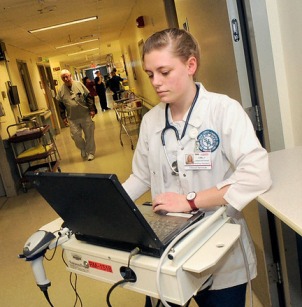Nursing Graduation Rates Continue to Rise in New York but Weak Job Market Could Halt Progress, According to UAlbany Report
Contact(s): Catherine Herman (518) 956-8150
 |
Newly-trained RNs face a very competitive job market due to the economic downturn, according to a new UAlbany study. (Photo Frank Ordonez, Syracuse Post-Standard) |
ALBANY, N.Y. (February 22, 2010) -- Registered nurse (RN) graduation rates in New York increased in 2009 -- the seventh consecutive annual increase -- but a weak job market could lead to future enrollment declines and future nursing shortages, according to a new report from the University at Albany's Center for Health Workforce Studies (CHWS). The report is based on an annual survey of deans and directors of New York�s nursing education programs to better understand trends in the production of new RNs in the state.
"The current economic downturn has reduced the number of RN job openings and newly-trained RNs now face a very competitive job market," said Jean Moore, director of CHWS. "The short-term impacts of the economic downturn may have longer-term consequences. If the job market for newly-trained RNs continues to be highly competitive, a possible market response to this perceived nursing surplus is a decline in interest in RN careers, leading to declines in RN enrollments and graduations. As a result, if the supply of RNs declines and the projections of future demand are accurate, then shortages are very likely."
Future demand for RNs is expected to increase as the population grows and ages. Advances in technologies that require increased skills, a continuing focus on preventive health care services, and the aging of the nursing workforce will all contribute to increased demand. However, projections of future demand for RNs cannot easily account for future economic conditions or the impacts of health care reform. Both of these factors will affect the number of available nursing jobs and ultimately, the number of nurses available to fill them.
"It is important for planners and policy makers to recognize the potential consequence of a decline in the production of new RNs, given projected future demand," said Moore. "These potential nursing shortages could prove much harder to reverse given the broad array of factors that may contribute to them."
Among the findings:
- Nearly 9,300 individuals graduated from RN education programs in New York in 2009, a 9-percent increase (762) over 2008. This was the seventh successive year that RN graduations have increased, following six consecutive years of declines. Total graduations for 2009 represent an increase in RN graduations of nearly 81 percent since 2002. The number of RN graduations in New York in 2010 is expected to be almost 92 percent higher than the number of RN graduations in 2002.
- The number of graduations from both associate degrees in nursing (ADN) and bachelor degrees in nursing (BSN) programs in New York is projected to continue to rise between 2009 and 2010. In 2009, ADN and BSN graduations increased over 2008 graduations by 10 percent and 8 percent, respectively.
- Half of nursing programs in New York wait-listed qualified applicants, with nearly two-thirds of ADN programs wait-listing qualified applicants. Overall, 50 percent of RN education programs in New York placed qualified RN applicants on wait-lists rather than admitting them directly into the RN education program, with 62 percent of ADN programs and 35 percent of BSN programs placing qualified applicants on wait-lists. Nearly 42 percent of the ADN programs reported that a majority of the qualified applicants who were on a wait-list were expected to gain admission into the nursing program. In contrast, only 18 percent of BSN programs reported that a majority of the qualified applicants on a wait-list were expected to gain admission into the nursing program.
- Fewer nursing program directors reported "many jobs" available for new graduates. The vast majority of nursing program directors consistently reported a strong job market for their graduates in the 2004 - 2007 surveys. However, in the 2009 survey, the percentage of program directors reporting "many jobs" for their graduates dropped by more than 50 percent.
- All regions in New York are projected to experience significant increases in RN graduations between 2002 and 2010, ranging from nearly 17 percent in the North Country region to almost 160 percent in the Finger Lakes region. Two other regions are also projected to more than double their RN graduations between 2002 and 2010 (Southern Tier and Long Island). RN graduations in 2010 are projected to surpass 1996 RN graduations in eight of the 10 regions of the state.
- RN graduations from privately sponsored nursing education programs are increasing faster than RN graduations from publicly sponsored programs. Between 2002 and 2010, RN graduations from publicly sponsored programs � the State University of New York and the City University of New York schools � are projected to increase by about 80 percent while RN graduations from privately sponsored programs (including hospital-run programs) are expected to grow by more than 110 percent.
The Center for Health Workforce Studies, located at UAlbany's School of Public Health, is a not-for-profit research organization whose mission is to provide timely, accurate data and conduct policy-relevant research about the health workforce. The Center's work assists health, professional, and education organizations, policy makers and planners, and other stakeholders to understand issues related to the supply, demand, distribution, and use of health workers.
![]() For more news, subscribe to UAlbany's RSS headline feeds
For more news, subscribe to UAlbany's RSS headline feeds
Educationally and culturally, the University at Albany-SUNY puts "The World Within Reach" for its 18,000 students. An internationally recognized research university with 58 undergraduate majors and 128 graduate degree programs, UAlbany is a leader among all New York State colleges and universities in such diverse fields as public policy, nanotechnology and criminal justice. With a curriculum enhanced by 300 study-abroad opportunities, UAlbany launches great careers. For more information about this globally ranked University, visit www.albany.edu. For UAlbany's extensive roster of faculty experts, visit www.albany.edu/news/experts.shtml.


